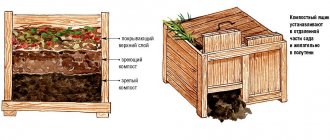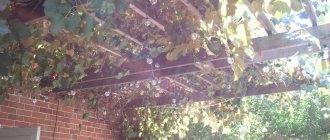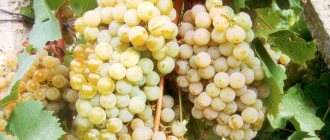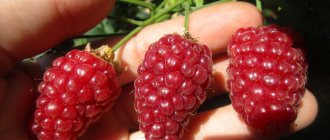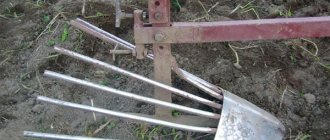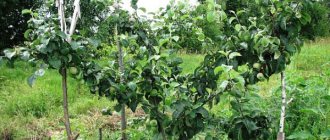Wild forest berries are good for health and contain a rich set of vitamins, but picking them by hand is a huge physical labor that requires good health and a lot of free time.
A simple device for picking blueberries, which I show with three simple designs, can reduce the load on the body and significantly speed up this process.
Their design, materials and manufacturing technology are different, which affects the process of harvesting berries. Therefore, get to know everyone and choose the option that suits you best.
What is such a combine?
According to the principle of operation, all devices used to collect forest and garden gifts are divided into 3 groups:
- manual;
- mechanical;
- vacuum
The last two groups are products manufactured industrially. Mechanical models are expensive and designed for farms and large industrial enterprises. Outwardly, they look like grain harvesters.
| Harvester type | Main machine components | Operating principle |
| Mechanical (trailer, self-propelled) | Conveyors | Pickers introduce branches into the space of shakers |
| Shakers | Berries fall onto the conveyor | |
| Pickers | The cleaning unit removes leaves and other debris. | |
| Cleaning unit | The cleaned harvest is sent to boxes | |
| Vacuum | Hopper capacity 12-15 l | Berry bushes are treated with a flexible hose-manipulator |
| Air duct (hose) with manipulator tube 1.2 m long | Raw materials (blueberries, lingonberries, cranberries) are moved through the tube to the container | |
| Bell with nozzles (combs) | Garbage is removed and does not enter the storage container | |
| Engine 7500 rpm | The device looks like a backpack, it has straps |
Comment!
Vacuum devices are suitable for harvesting hazelnuts.
Amateur gardeners and wild berry pickers use manual berry pickers. The materials that are used to make manual harvesters for collecting lingonberries and blueberries are different, but the design and operating principle of the devices have few differences:
- A mandatory element of all devices is a comb made of metal, plastic, wood, with teeth raised upward.
- The second important part of the berry picker is the body made of plastic, thick fabric, or metal. Berries are rolled into it when picked.
- The handle (handle) is needed for convenience. The berry picker is held with one hand during operation, and the branches with berries are directed onto the comb with the other hand.
- The damper is an additional, but not mandatory part of the device. It is mobile and prevents the berries from spilling out during operation. It is placed in the middle of the bucket; when it is lifted up, it opens slightly; when the scoop is tilted, the damper closes automatically.
Manual structures (grabbers, scrapers, combs, scoops, ladles) for picking berries are made with your own hands or purchased ready-made products.
| The best industrial combine harvester models | Description |
| Plastex | A machine with a convenient telescopic handle, it is used to collect the fruits of wild crops |
| K-1 | All parts of the device are metal; cranberries are harvested with this combine. |
| Bug | A plastic machine equipped with a comb is designed for collecting berries of different varieties and sizes. |
| Pigasov combine | Made of galvanized steel, comb pitch 5 mm |
| Alko | The material of the handle-holder and comb is plastic, the receiver bag is textile |
How and when to pick blueberries without damaging the berry plant: personal observations
I live in the middle climate zone, and I judge the beginning of blueberry ripening by observing the black currant fruits in the country. As soon as they begin to turn from brown to black, you can immediately head to the forest.
This usually happens at the end of the first week of July. At this time, the blueberry is not yet fully ripe; there are many small and green berries. It is not worth collecting them with mechanized devices: there is a lot of waste.
The leaves (like the fruits) stick very firmly to the bush and, when they get between the teeth, they crush and deform the berries, and when they come off the branches, they make picking very difficult. The garbage becomes saturated with juice and is difficult to separate.
During this period of time, I recommend abandoning any mechanisms and picking berries only with your hands. My speed is low: on average, I get a little more than 1 liter per hour, but it’s quite enough for home preparation and consumption, and I’m not involved in sales.
At this time, the collection is accelerated:
- a container for berries, made on the principle of a sippy inkwell, the ribbon of which I hang around my neck;
cups on the fingers of each hand, saving the movement of the berry picker’s hands towards the container.
I consider the optimal time for harvesting with mechanized devices to be the end of July and August: blueberries are gaining strength, and the fruits, reaching their maximum size and the greatest amount of vitamins, have a pleasant taste.
It is during this period that I make my mechanized devices. Nowadays it’s not a problem to buy a factory-made blueberry harvester. But it is prestigious for a home craftsman to do it with his own hands, taking into account his individual abilities.
In this case, it is necessary to take into account a number of technical features that take into account the physical properties of the ripe berry. I include:
- fruit size;
- separation force from the stalk;
- the state of the juice and the crushing strength of the shell;
- presence of garbage.
How does fruit size affect puller design?
A ripe blueberry usually exceeds 6 mm in diameter.
I take this indicator into account by the gap between the teeth of the combine, choosing it to be at least 5 mm. It allows:
- cut off some of the underdeveloped fruits, leaves, needles, and other debris;
- collect only ripe varietal berries;
- do not damage the bush.
Which tooth shape is safer to tear blueberries from the stem?
Among industrially produced combines, designs with teeth made of round wire predominate.
It is more convenient to make them this way, but this does not have a very good effect when the berry is torn from the stalk. I showed this process in the figure. I share my observations.
At the round tooth, the fruit is pulled into the recess shown by the dotted lines and is slightly crushed. A flat surface immediately tears the berry away from the stalk, deforming it less.
In this case, it is important to avoid sharp edges at the ends, which can push through the thin shell. I do this by forming a very small chamfer on the ribs.
The width of the tooth also affects the operation of the device. A narrow profile fits better between twigs and leaves and creates less clustering. This reduces the formation of debris in the gaps and does not injure the ripened fruits and the blueberry itself.
Required tools and materials
Do-it-yourself berry harvesters are made from plastic bottles, cans, plywood, and metal. The set of tools required for the job determines the material. When working with galvanized steel and wire use:
- hammer;
- metal scissors;
- welding or tin, flux and soldering iron for soldering;
- emery wheel;
- drill;
- chisel;
- pliers.
To build a harvester from wood (plywood) with your own hands, you will need a circular saw or jigsaw, a grinding machine or sandpaper, self-tapping screws, a drill, and PVA glue. The easiest way to work is with plastic. To work with this material, a knife and scissors are enough.
How to make a manual harvester for picking berries from a bottle with your own hands
The device is used for picking raspberries and blackberries. For production you need the following materials:
- 0.5 liter bottle made of thick plastic;
- twine;
- stalk 60 cm.
This model is easy to manufacture; even a schoolchild can make such a berry harvester. Step-by-step recommendations:
- Markings are applied to the bottle. To do this, the template is cut out of paper and applied to the surface. The collection spout is located at the bottom of the bottle. A 1.5*1.5 cm wooden block, a metal-plastic pipe or a stick, cleared of bark, is used as a cutting.
- Using a stationery knife, make a hole according to the intended markings. In the place of the teeth, carefully cut through the plastic in small steps. The cutting is tied with twine to the resulting berry harvester.
The teeth encircle the stem, pulling the berry into the bottle
Drawings and dimensions
Making a harvester for picking berries with your own hands begins with drawing a drawing. The details of the body are drawn on graph paper or a piece of Whatman paper, indicating the dimensions. A ladle for collecting wild berries (lingonberries, cranberries, blueberries) consists of several elements:
- rectangular base;
- 2 sides;
- combs with teeth;
- top with handle;
- partitions.
The lower part of the bucket is not a solid part, it is a comb with teeth located at a distance of 5 mm from each other. Berries do not fall through cracks of this size, and small debris spills out. The drawing shows that the teeth are 1.5-2 cm longer than the body.
Design Features
Industrialists produce ready-made models of berry pickers. However, most models are made of plastic or thin, easily bendable metal. During harvesting, products are damaged and broken.
The design of the berry harvester resembles a container with a comb. After all, the bushes are “combed out” during harvesting. The berries remain in the receiver, and the branches are freed from the fruit. Models that allow you to harvest with minimal damage to the branches are valued, since in the future you will have to sort through the berries for a long time. Harvesters are suitable for harvesting the following berries
- currant;
- cranberry;
- cowberry;
- blueberry;
- cloudberry;
- gooseberry.
Most summer residents prefer homemade combine harvester designs. They are more reliable and durable. The box is made of plywood or wood, and the teeth are made of stainless steel rod. The knitting needles are threaded through the branches and the berries are combed out, which are lowered into the receiver. A properly made berry harvester can last five years or more.
Attention! To prevent damage to the fruits during harvesting, the edges of the spokes are rounded. To prevent the forks from bending and the berries falling, the rod is made of durable steel with a cross-section of 3 mm.
Drawings, dimensions of berry harvesters
A simple bucket with a collector and a comb allows you to quickly and efficiently collect berries. The length of the comb is 10-15 cm, the distance between the teeth is 5 mm.
The buckets are equipped with wooden handles; this detail prevents the hand from slipping and is convenient to use.
When the container is full enough, the berries are poured into a bucket. To prevent the crop from spilling out of the scoop, a hinged partition is installed between the comb and the collector.
Such models are not suitable for picking strawberries, strawberries and raspberries.
The bucket sizes are varied. Experts consider combine harvesters with the following parameters to be the most convenient for work:
- base (collection) – 7*15 cm;
- sidewalls – 15-20*25-30 cm;
- distance between teeth – 5-6 mm;
- height of the structure – 10 cm.
The bottom wall of the master is made of metal mesh, wooden blocks and a comb
Manufacturing instructions
From funds found at home, homemade devices for collecting forest gifts are made without drawings. The dimensions and shape of the devices determine the dimensions of the plastic products (bottles, containers) from which the bucket is made.
More complex products made from materials such as metal, wood, plywood are made strictly according to the scheme. First, patterns of all parts of the device are drawn on paper or cardboard, then they are transferred to metal or plywood sheets.
From sheet metal
A step-by-step description of the process of making a blueberry harvester with your own hands will help you in your work:
- take a galvanized sheet and apply the contours of the bucket body parts onto it according to a template;
- cut out all elements of the future design with metal scissors;
- Cut rods from wire (1-3 mm), at the comb of the scoop they will be the bottom and teeth;
- connect the body parts with rivets;
- Attach a curtain inside to the hinges; it will prevent the fruits from spilling out when picking;
- make a handle from a piece of pipe, flatten the ends and rivet them to 2 bent strips;
- Rivet the holder with handle to the body.
For the berries, sew a bag from coarse fabric and attach it with thin wire or rope to the body of the bucket. Bend the spoke teeth of the comb smoothly upward. How to fix the comb spokes is worth considering in detail.
Comment!
To make the hand comfortable, the steel handle is wrapped with several layers of electrical tape.
First, cut out 2 strips of galvanized steel, 3 cm wide and equal to the width of the comb. Fold each strip in half and cut 2 cm from each side of one half. On the fold, mark locations for holes with a pitch of no more than 5 mm.
Make cuts exactly according to the markings using an emery wheel. Insert wire into the holes of the first and second plates and solder them so that they do not fall out. Using a chisel and hammer, shorten the spokes to the same length and bend them.
Made of wood
Make a device for collecting berries from thick 9 mm plywood. Make a comb from old bicycle spokes or 3 mm wire. Place the templates of the body parts on a sheet and outline the contours. Using a jigsaw or hacksaw, cut out the blanks strictly along the drawn lines.
How to make a rake-harvester for picking berries with your own hands
Another option for a manual assembler. For manufacturing you will need galvanized iron and stainless steel knitting needles. Operating procedure:
- Parts are cut out according to the selected drawing. To do this, use a marker to mark the galvanized sheet. Knitting needle holders are made from strips. To do this, place a piece of plywood or iron 0.5 cm thick on the segment and bend the segment in half through it.
In increments of 5 mm, using a grinder and a metal disk, make notches 2-3 mm deep for installing knitting needles
- Cut 2 cm from each end in one layer for ease of fastening. The resulting segment is attached to 5*18 cm strips (sidewalls).
Insert the knitting needles into the holes and alternately solder them with tin to fix them to the first and second strips
- A piece of aluminum pipe is flattened at both ends. Strips are attached across to the center, 1 cm wide.
Drill holes at the ends using a cutter and bend them 1.5 cm
- The knitting needles are leveled to the same length of 5-7 cm. Holes are made in the corners of the sidewalls. Attach the handle to the ends.
The tips of the knitting needles are bent in the shape of an arc
Attention! When working with power tools, you should follow safety precautions. Wear protective gloves, goggles and an apron.
To prevent the berries from rolling to the ground, a canvas bag is attached to the back wall. Some craftsmen cut off part of the leg from old thick jeans, sew a hole on one side, and attach the other part to the bottom using twine or wire.
Vacuum cleaner for collecting chokeberry
You will need a corrugated hose from an old vacuum cleaner, a plastic beer bottle with a long neck. It needs to be cut so that there is a piece left for joining with the corrugation. In the lower part of the cylinder, cut a window in which the lower edge is decorated with teeth.
Cutting teeth is difficult; you need a sharp knife. Assemble the combine:
- insert a cylinder with a jagged window into one end of the pipe for collecting berries;
- Secure the joint with several turns of electrical tape;
- Attach a T-shirt bag to the second end of the corrugation with electrical tape.
Comment!
The T-shirt bag needs to be intact, without holes. Picked berries will fall into it.
The operating instructions for this vacuum cleaner are simple. Hold the branch with one hand, and use a ladle to pick off the chokeberry fruits with the other hand. They will roll down the hose into a bag.
Harvester for picking blueberries and strawberries, photo, video
A device for picking blueberries allows you to harvest a much larger harvest.
In the summer, picking berries is one of the favorite activities of summer residents and gardeners. There are many devices that help greatly facilitate and speed up this process. To understand how to make a harvester for picking blueberries, lingonberries and strawberries yourself, let’s look at the features of picking berries.
Peculiarities of picking blueberries and strawberries
Picking blueberries and wild strawberries is a labor-intensive and painstaking process. The berries are small, the bushes are low and grow densely. Harvesting by hand is incredibly difficult—you literally have to pick one berry at a time from all the greenery. In this case, you need to stand bending towards the ground.
Blueberry picking
Most often, blueberries are found in pine and small-leaved forests. Finding a berry bush is quite simple: a clear sign of the presence of shrubs is a wild plant - wild rosemary. It has a distinct smell, which will become your guide.
There are also cultivated varieties of blueberries that gardeners grow in their summer cottages. The bushes of such plants are taller, but less common, and the berries are larger, and therefore it is much more convenient to collect them than forest ones.
Hand picking blueberries in the forest
Bushes can reach an age of 40 years. The oldest ones occupy a large area and have a spreading shape. They bear a lot of berries, but they are smaller than those on young plants.
The most delicious and healthy fruits grow on young animals, whose age does not exceed 10 years. They have thin green twigs, and thick side branches are practically absent.
It is recommended to collect blueberries in small plastic buckets or baskets. It is not worth pouring the harvested crop from one container to another, since the berries, although strong, are easily damaged. You should not pick blueberries after rain; it is better to choose dry morning weather.
Collection of forest and garden strawberries
Picking strawberries also has its own characteristics. Both a wild forest and a garden berry, it loves well-lit, open areas. Ripe and ready-to-eat fruits have a bright red color and are easily separated from the stalk.
Hand harvesting strawberries
The fruit cups can be removed immediately, or the berries can be sorted later. The best time to pick strawberries is in the morning, when the dew has dried. The fruits must be collected in small containers of 2-3 kg. It is not recommended to overspray; the berries are soft and easily damaged.
Factory-made blueberry harvester
A scoop for picking blueberries is the simplest and most popular device among lovers of this berry. Despite its simplicity, it performs its functions perfectly and speeds up berry picking by 3-4 times.
Hand scoop for harvesting blueberries
A ready-made combine is not expensive at all, and therefore is very popular. You can buy it at both hardware and gardening stores. The device has several names: a scoop or berry harvester, a fruit picker, and a berry picker.
The device for collecting blueberries is a parallelepiped-shaped container, on the bottom wall of which there are long curved teeth, reminiscent of a comb. With their help, the bushes are literally “combed out.”
Blueberry scoop with plastic body
The distance between the teeth is approximately 5-6 mm. Thus, the branches and leaves of the bush pass freely between them and remain undamaged, and the berries are carefully removed and fall into the rear compartment of the scoop.
Metal harvester for collecting blueberries and lingonberries
There are various factory-produced models and those made by yourself. The material used for the body is plastic, metal or wood. Wire is almost always used for the teeth.
How to make a blueberry harvester with your own hands
A simple device can be easily made from available materials. Leftovers and trimmings of boards a few mm thick are suitable for this:
- prepare paper patterns of all parts: 2 side and 1 back wall, top, bottom, handle, part with teeth;
- place the patterns on scraps of wood, trace the outline and cut out;
- connect the parts with nails.
A homemade blueberry harvester may have teeth made of thick wire. It is necessary to make several long loops and secure them to the bottom of the device. To learn how to do this, watch the video.
Harvester for picking blueberries from a plastic bottle
The most affordable way to quickly make a device is to use a plastic bottle as a base. Before making a scoop for collecting blueberries, the bottom of the container must be cut off.
Harvester for picking blueberries from a plastic bottle
If you cut the teeth out of plastic, they will be soft and you will not be able to comb out the bush. To do this, use wire. You can easily bend 8-10 cloves out of it and attach them to a plastic base. This homemade scoop is light and convenient, and it only takes a few minutes to make.
Device for picking strawberries: truth or myth
Today, forest and garden strawberries have to be picked manually. The wide, three-lobed leaves do not fit between the teeth of the combine and are often torn off. Using the previously described scoop to collect strawberries, there is a high probability of damaging the tendrils with young bushes extending to the sides, and the berry itself is soft and easily damaged.
Harvesting strawberries and wild strawberries is only possible by hand
When growing strawberries on an industrial scale, producers use modern high-tech machines. A strawberry harvester is an expensive and fairly large piece of equipment. To use it, you must respect the shape and height of the ridges. The use of such equipment in a small private household does not pay off.
Industrial harvester for collecting strawberries video
A device for picking strawberries is the dream of many gardeners and foresters. Therefore, to increase sales and for advertising purposes, the blueberry and lingonberry harvester is credited with the ability to harvest strawberries. The problem is that many people believe this, and in the process spoil the berries and harm the plant.
Trial device for picking strawberries video
In an attempt to make the process of picking strawberries easier, craftsmen use all their ingenuity. This video shows a simple do-it-yourself device, with the help of which craftsmen will try to speed up the berry harvesting procedure, but the quality of the harvest will most likely be spoiled.
Bottom line
Today there is a lot of information on how to make a device for picking blueberries, but such combines and scoops are not suitable for strawberries. Engineers and craftsmen are constantly inventing something new, and perhaps a device capable of picking delicate berries will soon appear.
Device for collecting rose hips
Rose hips sit tightly on the branch and are difficult to tear off. An ordinary comb will not work. To make a harvester for collecting rose hips with your own hands you will need:
- a piece of plastic sewer pipe;
- blades from a construction knife;
- knife;
- insulating tape;
- pipe plug.
The device can be made in two ways.
First option
Take a gray sewer plastic pipe with a diameter of 150-160 mm. Cut a piece to the required length. The size of the device depends on the preferences of the fruit picker, his height and strength. Make 3 deep slits of the required width from one edge.
Pros and cons of blueberry picking devices
The device looks like a small container with a comb at the end. The harvester, like a comb, slides between the branches of the bush, grabs the fruits, separating them from the stems with the help of “cats” - special curved hooks. The advantage of the device is that it speeds up berry picking and simplifies the procedure. The user of the mechanism is less tired. A novice picker can collect up to 12 kg of blueberries, blueberries or other berries in 7-8 hours.
A simple factory-made device is inexpensive - about a thousand rubles, which allows you to pay for it on the first day of collection. In addition, you can make a harvester yourself from scrap materials. The device also has negative sides: damage to berries and bushes. When harvested using this method, young shoots with leaves are cut off, which leads to a decrease in fruiting.
Device for picking cranberries while standing
Such a device can be made by a master who is fluent in tools. It is quite complicated, but you can use it to pick cranberries without bending over. All the parts of the box are cut out from a piece of thick plywood, as well as the comb strip.
The comb is easy to make:
- a number of holes are drilled in the plank;
- cut the wire into pieces of the required length;
- the teeth are fixed in the holes with glue.
Comment!
To prevent cranberries from spilling out during harvesting, install a movable plate.
The back wall of the bucket is made composite, the lower part is movable. It is attached to the top part on furniture hinges, and fixed to the side walls with pieces of rubber. This design allows you to stand and pour cranberries into a bucket.
To do this, one end of the rope is attached to the lid, the other is tied to a movable handle, which is bolted to a high handle made of 2 plastic tubes. Their length is determined empirically to make it convenient for the assembler.
How to make a harvester for picking berries while standing with your own hands
The improved design allows you to harvest without bending. This makes it easier for older people and those who suffer from back pain. Even an athletically trained person, after a whole day of bending and squatting, will suffer from muscle soreness the next day.
For work you will need a sheet of plywood with a thickness of 7-10 mm and a stainless steel rod with a cross-section of 3 mm.
The procedure for performing work on the manufacture of a harvester for picking berries while standing:
- Markings are applied to the plywood according to the selected sketch using a simple pencil, clearly measuring the size of the parts.
Elements are cut out using a jigsaw and a file for figure cutting.
- Using self-tapping screws and a screwdriver, attach the bucket parts to the bottom and sides in accordance with the drawing.
Parts can be fastened with nails and a hammer
- Hinges are attached to the rear end wall and checked that the part moves freely. The door is mounted to the berry picking box.
To ensure that the part opens only when it is necessary to empty the collection, it is fixed with an elastic band, one end of which is attached to the wall, and the other to the side
- From a stainless steel rod with a cross section of 3 mm, cut into pieces 10 cm long. The part is coated with universal glue and the knitting needles are glued. On the outside, the teeth are sharpened so that the surface is smooth and rounded.
In increments of 4-6 mm, a hole is drilled in the holder using a drill and a wood drill with a diameter of 3 mm
- The resulting comb is glued into a berry harvester. To ensure good adhesion, the parts are strengthened with a clamp.
To make the combine more durable, self-tapping screws are screwed into the sides to securely fix the rake.
- Using metal corners and self-tapping screws, a handle is attached to the collection.
The handle is cut out of plywood according to a template
- Take two pieces of pipe 1.3 m and 0.7 m. These are the future handles. Rotating elements made of plywood are screwed to the parts on one side.
The collection holders are attached to the handle using self-tapping screws
- Having retreated 10 cm from the small pipe, the two sections are fastened together with a piece of pipe and the remaining parts of the rotating mechanism.
An indentation of 10 cm will allow you to regulate the movement of the harvester while picking berries.
- A bolt is screwed to the rear wall in the center. Using twine, connect the door and the attachment point of the two pipes.
Stepping back 20 cm from the top edge of the long handle, attach a belt to secure it on your hand.
- Testing is carried out in the field.
To free the harvester from berries, pull the rope and the door opens, so you don’t have to bend over even to free the harvester
Harm of mechanized berry picking for berry bushes
Devices for collecting fruits make work 2-3 times easier and faster, which is why they are actively used by harvesters. Handmade tools injure bushes if certain rules are not followed during their manufacture.
Devices are considered safe if there are no sharp cutting edges and the ends of the teeth are rounded. The comb does not scratch the stems during operation. The gap between the spokes is optimal, allowing leaves and branches to pass through, but delaying fruit.
Devices that do not meet these requirements are considered poaching devices. The Ministry of Natural Resources is fighting against their use. With a barbaric attitude towards nature, the productivity of berry fields decreases, and it takes years to fully recover. In Russia, Ukraine, and Belarus, collectors are fined for using poaching hand-held devices.
Classification of berry harvesters
Cranberry harvesters differ in design and the presence of mechanization:
Manual type model without the function of mechanized collection of ripe cranberries. In a homemade design, the design is similar to a small rake with a short handle attached. A box or cloth bag is attached under the teeth to collect falling cranberries. Shop fixtures are made more accurately. The design is a bucket with a handle. The branches with cranberries are grabbed with metal or wooden teeth.
Manual harvester with the function of mechanized cranberry harvesting. The body of the device is equipped with a motor. Cranberries are collected using vibrating teeth or vacuum suction.
Automatic combines. A full-fledged mechanism on its own, controlled by the operator. Externally, the machine is similar to a grain harvester, but instead of a mower, a cranberry harvesting attachment is installed.
Based on productivity, combines are divided into 3 classes:
For home use, household models are used.
Video of cranberry harvesting using a combine harvester:
